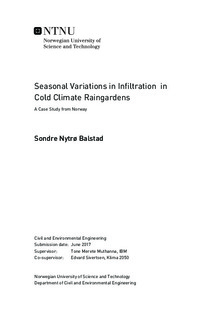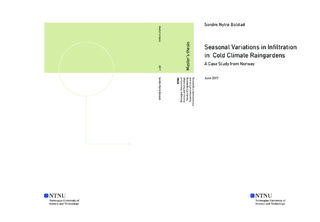| dc.description.abstract | Winter infiltration in cold climate raingardens is a key function for proper year round function. The Modified Phillip-Dunne Infiltrometers (MPD) procedure was used for measuring winter variation in infiltration capacity in a raingarden. The research was based on a case study approach, combining field measurements and simulations. The results were compared to publicized results from the raingarden at Risvollan and literature values addressing cold climate. Saturated hydraulic conductivity (Ksat) provides a measure of infiltration capacity and is recommended to be above 10 cm/h in cold climate raingardens. The results show a seasonal variation in Ksat, from 1 cm/h (October) to 0.05 cm/h (November-April). Simulation of a raingarden in Trondheim, show a change from 75 % to 25 % in the amount of winter inflow the raingarden infiltrate or drain when Ksat goes from 1 cm/h to 0.05 cm/h. This paper presents a winter adaptation of the MPD-method. Few similar studies have been carried out in cold climates. Of these, few investigated the seasonal variations in infiltration capacity. | |

